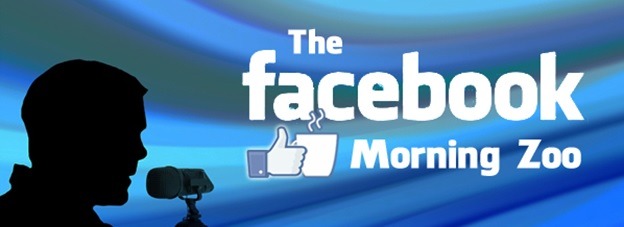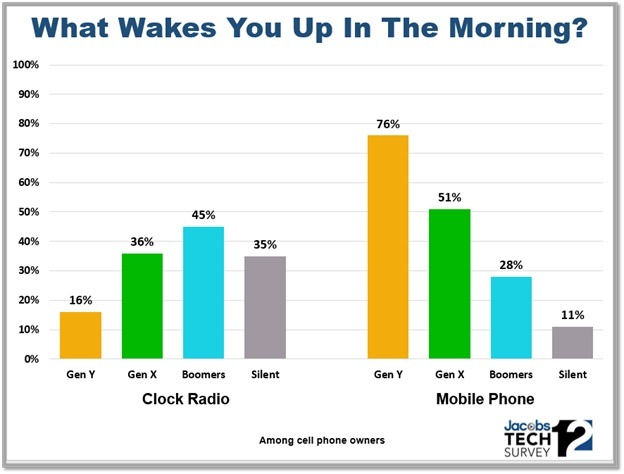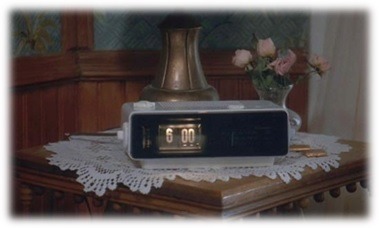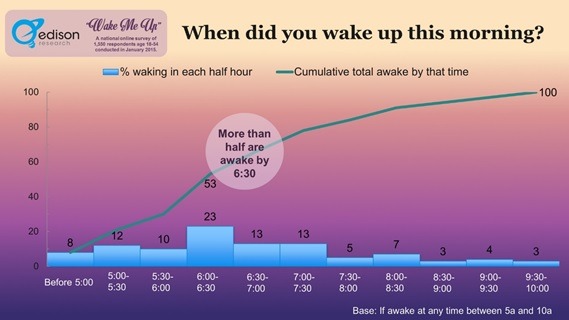
The release of a new Techsurvey is always a chaotic time for us here at Jacobs Media. First, there’s just the deluge of data generated by nearly 40,000 respondent interviews. Second, there’re the constant reminders on the spreadsheet about how the media landscape is undergoing rapid change. And finally, there’s the feedback I get from many of you who see the study in webinars, market visits, and industry conferences and presentations.
One data point that has garnered attention these past few weeks is actually something that’s been sneaking up on radio for more than a decade – disruptive wake-up patterns. Back in our very first Techsurvey we started noticing two things – more and more consumers were dumping their landlines in favor of their cell phones, and they were also beginning to use these mobile gadgets to rouse them out of bed in the morning.
Those first findings – the erosion of landline homes – turned out to be important because the Arbitron Advisory Council used the data to make the case to the execs in Columbia that a methodological change was necessary in order to incorporate “cell phone only” homes into its surveys. Arbitron got the message and modified their policy, much to the relief of younger-targeted stations where landlines were rapidly becoming extinct.
But the second piece of data – mobile phones doing the job that was once the domain of clock radios – has proved to be a thornier problem. In this year’s Techsurvey12, there are now more people waking up to their iPhones and Samsung Galaxy phones than to that once ubiquitous fixtures on nightstands – the AM/FM clock radio.

This is especially the case among Millennials. In TS12, three-fourths now use their phones as their wake-up devices. That’s why our mobile app development company – jācapps – created an alarm clock feature that plays the station stream in its earliest version of station apps. And yet, radio has been slow to communicate this benefit to its audiences, assuming incorrectly that just like that annoying clock radio in Groundhog Day, millions of listeners are still waking up to radio’s morning shows thanks to the nightstand clock radio (and hopefully it’s not playing “I Got You Babe”).
 This wake-up conundrum for radio is emblematic of the bigger challenge facing radio’s a.m. drive shows – the onslaught of new morning show competition.
This wake-up conundrum for radio is emblematic of the bigger challenge facing radio’s a.m. drive shows – the onslaught of new morning show competition.
Television was first to get serious about competing with radio for the morning share bonanza. Every market started multiple versions of “Good Morning, Des Moines,” with a team consisting of upbeat news anchors, hanging out with weather, sports and traffic personalities.
On the network level, Morning Joe on MSNBC is the best radio morning show on TV. And across the TV spectrum, there’s now a lot of competition on television, not just for program content, but for pop culture attention. Consider the drama created by Kelly Ripa’s inability to hold down a co-host. The deteriorating relationship between her and Michael Strahan has created more talk, buzz, and web/social chatter than anything your morning show has been talking about lately.
But the big news is that Facebook is launching a morning show called “Rise and Shine.” (Interestingly they didn’t go the radio route here by calling the show “Morning Sickness,” “Morning Zoo,” or something equally unappealing.)
The model is a bit sketchy at this point, but it looks like several days a week, the monster social network will serve up a news feed comprised of videos, photos, and other content designed to get us going in the morning.
Working with DigitasLBi, Facebook’s morning show will be live-streamed. According to Adweek, “Rise and Shine” will also feature local weather, as well as other content pieces that could include exercise workouts, recipes, and other lifestyle nuggets. Clearly, there’s a big sales component here, as both Facebook and DigitasLBi hope to attract sponsors to the show.
The head of Facebook’s Creative Shop Studio told Adweek, “It will appear in those morning wake-up hours where you are getting up, you could use a little (content) to get you going.”
Sounds like something radio is supposed to do. And in fact, that’s been a theme on this blog in the past couple years where more and more digital brands are going after what were once radio franchises. In this case, it’s the morning show.
We know a lot of people wake up and check their Facebook feeds before accessing any other media. “Rise and Shine” could make that an even stickier, customized first-thing-in-the-morning experience.
This would seem like one of those times to sit down with local market morning shows (and perhaps some of the syndicated shows, too) and have that reset conversation. Here are some discussion points:
1. An earlier, stickier start
An Edison Research study indicates the peak time when people wake up is between 6:00-6:30. And yet, how many morning shows still view that 6 o’clock hour as a time to warm up and not do their best work? Between TV’s morning shows and now Facebook, strong, energetic content is out there. It’s essential for morning radio talent to get started early and bring their A-level content to the 6am hour, if not earlier.

2. Smart, strategic setups
Bits and features that take a minute (or longer) to explain and launch are toxic. One of the interesting insights about the NPR One app is realizing just how quickly listeners skip to a new content piece. Zach Brand told us in a “Radio’s Most Innovative” post in 2015 that 37% of skips occur within the first three seconds a segment starts. You can argue that timing might be different when listening to an actual radio. But NPR One data suggests that consumers are growing impatient and fickle, exercising their options in a visceral, reactive way without a lot of thought. It is essential that – especially in the morning – content is strategically set up and lifts off quickly. Too often, talent takes a minute or more to set up content, giving morning risers a chance to look elsewhere.
3. Occasion setting works
On a Facebook feed, you just keep scrolling until you find something you like. On the radio, programmers, producers, and talent have to work harder. And that means a smart strategic posture designed to keep the audience coming back (or staying around) for the next segment. In qualitative interviews we conduct, we hear listeners tell us how effective savvy occasion setting can be in helping them look forward to waht’s coming next. Morning talent needs to do this with frequency, efficiency, and effectiveness to combat consumers wandering away during long commercial breaks.
4. Video works
New competition like TV morning shows and now Facebook rely heavily on videos and visuals. Some morning shows have gotten the memo, but many continue to do “visual bits” or sit in the studio and talk about a photo or video on their screens, leaving the listener feeling left out and frustrated. Broadcasters need to invest in video, talent needs to commit to wisely using it, and programming needs to guide this process in order to take advantage of screens and visual content. That’s where it’s all headed.
5. Socialize smartly
If the world’s most robust and ubiquitous social network is up and at ’em with their version of a morning show, it’s essential for radio’s a.m. drive talent to be present on Facebook as well. Even if they start their mornings with “Rise and Shine” on Facebook, they’re in position to see a clever, compelling morning show post in their feeds. Many of radio’s morning shows are using Facebook with regularity, acknowledging the audience and getting conversations going. However, many others still view social as an afterthought – something they can get around to when every other task is complete. In this environment, that’s a short-sighted approach, ignoring where eyes and ears truly are.
Facebook’s “Rise and Shine” morning initiative is a wake-up call for radio – and it’s not coming from a clock radio.
- What To Do If Your Radio Station Goes Through A Midlife Crisis - April 25, 2025
- A 2020 Lesson?It Could All Be Gone In A Flash - April 24, 2025
- How AI Can Give Radio Personalities More…PERSONALITY - April 23, 2025




Leave a Reply